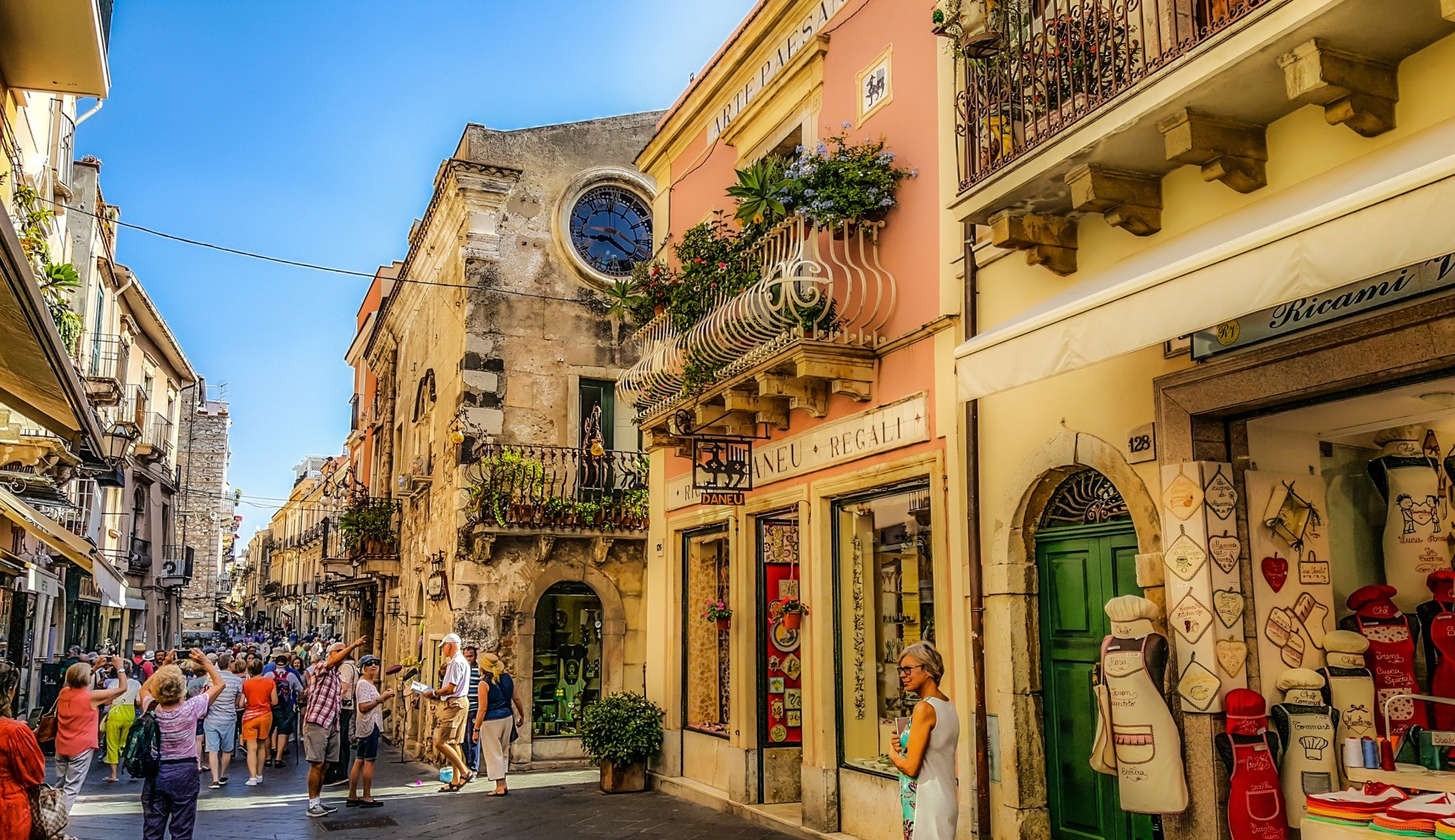Are you wondering what is the best time to travel to Sicily? Being based here my whole life, I’ve learned a lot about the seasons and how they differ from other parts of the country.
Luckily, we’re gifted with a Mediterranean climate, so we escape heavy rainfall at certain times of year that other destinations suffer from. But, like anywhere, certain times of the year are much more favorable than others.
I’ve used my knowledge and experience to put together a detailed outline of the best time to travel to Sicily so you can make an informed decision regarding your vacation.
What’s the Weather Like in Sicily?
Understandably, this tends to be the first question I’m asked by anyone considering a trip to Sicily. As most of us know all too well, the weather can significantly impact the kind of experience you’ll have.
Sicily has been blessed with a typical Mediterranean climate, meaning we usually enjoy yearly weather of hotter summers and much milder winters than many of our European counterparts. Because of this, Sicily is a pretty superb vacation spot at any time of the year.
The average winter temperature ranges from 10°C to 14°C and rises to upwards of 30°C during the summer. Sea temperatures can be as high as 28°C for the warmest months of the year and rarely drop below 15°C even in winter.
Though we’re no stranger to a few downpours here in Sicily, rainfall is usually only frequent from late October to January.
For the rest of the year, the low-altitude parts of the island don’t tend to get much rain, but more elevated areas tend to be wetter. It’s not uncommon for Sicily to receive little to no rainfall in July and August, the driest months of the year.
What Are the Different Seasons in Sicily?
Due to its Mediterranean climate, Sicily can be described as having just two seasons: winter and summer. However, this differs slightly as you move towards more inland regions. Four-season cycles are typical of these areas, as there’s more of a distinction between weather patterns.
When looking at the best times to travel to Sicily, it’s easiest to break the year into four seasons to get a clearer insight into what you can expect regarding weather.
March to May
When spring rolls around in Sicily, the coldest and wettest months of the year are behind us, and the temperatures start to climb. In March, things heat up to around 18°C as the months progress, but by May, it increases to highs of 24°C.
These favorable conditions and the reasonable prices that come with it make it one of the most pleasant times to visit Sicily. I generally recommend the latter half of the season for first-timers, as the comfortable temperatures are excellent for sightseeing.
Not only will you avoid the often arduous task of wandering around the Valley of the Temples and Taormina’s Greek Theater under the beating sun, but you’ll do so with a fraction of the crowds.
This time of year is also a hit with adventurous travelers. If you’re a keen hiker like me, you’ll struggle to find a better time to complete the bucket list Mount Etna hike than this.
While Mount Etna is Sicily’s most famous trek, I’ve found the coastal trails at Zingaro Nature Reserve and the climb to the summit of Stromboli volcano equally mesmerizing this time of year.
June to August
With high temperatures and European school holidays on the horizon, June to August is consistently the busiest and most expensive time in Sicily.
Sicily, in summer, starts to sizzle, and with each passing year, it becomes increasingly common for Sicily to surpass 35°C occasionally during July and August.
Even as a Sicilian accustomed to soaring temperatures, I find the intense heat that can arise during the summer overwhelming. For your own comfort and safety, I’d steer clear of Sicily at this time if you’re eager to embark on some outdoor excursions during your trip.
If you’re visiting between June and August but still want to check out some tourist hotspots, it’s best to set off early in the morning. Speaking from experience, wandering the streets of Palermo at midday in summer isn’t for the faint-hearted!
Nonetheless, swathes of visitors flock to the beaches along the Sicilian coast at this time. The turquoise waters provide some much-needed relief from the scorching sunshine, though I’d still suggest staying indoors until the peak heat has died down.
After sundown, Sicily comes to life again, and the streets are bustling with al fresco diners and lively bars open until the early hours.
September to November
September is still quite popular with tourists, but both the crowds and temperatures gradually reduce. The temperatures are typically around 27°C, and the warm weather continues into October before cooling to an average of about 15°C by mid-November.
Although November is much too chilly for us Sicilians to hit the beach, it’s common to spot locals and tourists taking a dip in the sea up until late October. Similar to the latter half of the spring season, the start of autumn is ideal for travelers who want to hit the tourist attractions and the beach but without the peak season masses.
The milder weather in October provides another terrific opportunity for hikers to embark on the world-class trails of their choice. Unfortunately, rainfall can become a little more frequent as the month goes on but is usually more prevalent by November.
That being said, I think November is a fantastic alternative to warmer months if you don’t mind a few showers and prefer lower temperatures.
December to February
Winter is in full swing from December to February, but you won’t need to worry about the snowstorms and sub-zero temperatures you’re probably envisaging! Things usually hover around 10°C to 14°C, and the rain peaks in December before slowly easing off over time.
Prices across Sicily are at their lowest, making it the cheapest time to visit. This is always a welcome relief to us locals and cost-conscious travelers who are looking for a getaway but on a tighter budget.
Better yet, you’ll have a chance to enjoy the island’s sights, smells, and sounds with just a handful of other tourists.
Of course, arriving during the quietest season has some cons. Reduced footfall means fewer accommodations, restaurants, and tours are available to book, and the weather is much too cold for lounging by the beach.
Despite this, winter is one of my favorite times of year in Sicily, but it may not be ideal if you want to see it in all its Mediterranean glory!
Are There Any Events That Take Place in Sicily at Different Times of the Year?
Sicily hosts a ton of unique and exciting events and festivals throughout the year. I may be biased, but nothing encapsulates my homeland’s vibrancy and culture like a Sicilian celebration!
I’ve included some of my all-time favorites worth considering when mapping out your travel itinerary.
February: Feast of Saint Agatha – Saint Agatha is the patron saint of Sicily, and over one million people descend on her birthplace, Catania, each year. To mark the anniversary of her martyrdom, fireworks, food, and magnificent processions take over the East Coast City.
March: Almond Blossom Festival – Every March, the southern province of Agrigento hosts the Almond Blossom Festival. Showcasing Sicilian folklore through song, dance, dress, and storytelling, this event is a can’t -miss for culture buffs.
July: Taormina Film Festival – Anyone with an affinity for the silver screen may already be familiar with the Taormina Film Festival, one of Europe’s biggest events for the movie industry. The festival’s setting in the historic Greek theater is simply magical.
September: Cous Cous Fest – The seaside town of San Vito Lo Capo is perhaps best known for its Cous Cous Fest. Over ten days, revelers celebrate Sicily’s multiculturalism through mouthwatering food and live music.
Frequently Asked Questions
When Is the Rainy Season in Sicily?
Rainfall in Sicily is at its heaviest from October to January, with December being the rainiest month. Therefore, it is not the best time of year to visit. However, due to climate change, it can be hard to predict when exactly the heavy rains will kick off and finish.
What Months Should Be Avoided in Sicily?
Sicily is a year-round destination. However, you might want to avoid the months of June to August to skip the often sweltering temperatures or late October to January when rain is most persistent.
What Is the Warmest Month in Sicily?
August is generally the warmest month in Sicily, with temperatures going over 35°C. So, don’t forget your sunscreen if you’re coming around then.
So, What Is the Best Month to Visit Sicily?
The best time to travel to Sicily will depend on your preferences, so what’s most suited to you may differ from other travelers.
I don’t think you can go wrong with visiting in April, May, September, and October. These months offer a mix of delightful temperatures and moderate crowds, allowing you to experience the sun-kissed shores, must-see sights, and anything else you’d like to do without your plans being affected by the weather.





